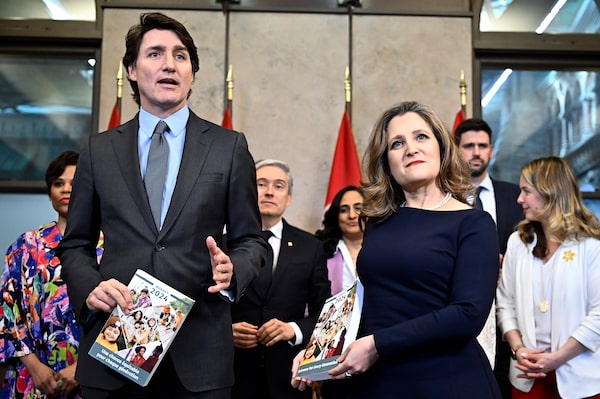
Prime Minister Justin Trudeau, Finance Minister Chrystia Freeland and cabinet ministers pose for a photo before the tabling of the federal budget, in Ottawa, on April 16.Justin Tang/The Canadian Press
In the run-up to the 2015 election, the federal Liberals touched an electrified third rail of Canadian politics: they promised to raise taxes. It only applied to high-income earners but still, it was a tax increase. And the party didn’t try to hide the plan. It put it in the platform. It talked about it during daylight hours.
The Liberals won the election.
On Tuesday, Finance Minister Chrystia Freeland touched another high-voltage wire, with a plan to raise the tax rate on capital gains. Only some capital gains, and only over $250,000 a year, and with small business largely shielded by a $1.25-million lifetime exemption, and with Ottawa saying that only 0.13 per cent of taxpayers will be affected – but still: a politically impossible tax increase is, apparently, possible.
There are lots of other third rails in Canadian politics – long-standing and costly policies that governments will not touch, no matter their illogic or unfairness, for fear of electoral electrocution.
But what if governments dared to go there?
Since I’m not running for office, I can.
Let’s start with one of the highest-voltage wires in federal politics: Old Age Security.
The Mulroney and Harper governments both got burned when they tried to reform OAS. The Liberals unreformed. In 2016, they reversed a Harper-era plan to raise the qualifying age from 65 to 67. Two years ago, they raised payments for everyone 75 years and over by 10 per cent.
OAS only begins to be clawed back once a senior’s income exceeds $91,000. And payments aren’t zeroed out until income hits $148,000 – or $154,000 for those 75 and older. Senior couples earning a quarter-million dollars a year, and living mortgage-free, are getting cheques from younger and (much) lower-income taxpayers.
Middle-class Canadians could be hit by increases to capital gains tax. Here’s how to prepare
That has to be fixed. The OAS threshold should be lowered – to, say, $60,000 – and the clawback sharpened, with benefits tapping out at $100,000. The 10-per-cent boost for the oldest seniors should also go: in 2021, the Parliamentary Budget Officer estimated its cost this year would hit $2.3-billion.
Some of the savings could enrich the Guaranteed Income Supplement for poor seniors. The rest could go to investments in young people.
What’s next?
End the capital-gains exemption for principal residences. It’s even more untouchable than OAS. It’s also more economically harmful and inequitable.
That a family home can be sold or passed on tax-free – unlike other investments – is a huge incentive to overinvest in housing. That’s what the tax code is telling Canadians to do.
It pumps up housing prices and pushes more and more national wealth into housing. It’s dumb economics, plus the tax break only goes to the two-thirds of families who own a home. And the richer you are, and the more home you own, the bigger the tax break. It adds up to a hyper-regressive policy to make Canada less productive.
What would a (clearly unelectable) Keller Administration do? It would tax capital gains on homes.
There could be a lifetime exemption of, say, $1-million. Beyond that, increases in a home’s value would be subject to capital-gains tax at sale or death, just like other assets.
The federal Department of Finance’s most recent annual Report on Tax Expenditures projects that the tax break for homes will cost Ottawa an average of $6.5-billion a year between 2022 and 2025.
Any other third rails to grab? Yes.
Tax corporate health benefits. An extra $1,000 in salary is taxed as income; an extra $1,000 in health and dental benefits is not. It’s illogical and inequitable. The PBO says that corporate health benefits are mostly going to upper-income Canadians, and lower-income people with benefits would be largely shielded from tax by the medical expenses tax credit.
The Department of Finance projects that this year, the tax exemption of private health and dental plans will cost Ottawa $3.9-billion.
More?
Let’s restore the two percentage points of Goods and Services Tax the Harper government cut. Our tax system is too tilted to income taxes, and away from taxes on consumption. And the cut to the GST costs Ottawa about $20-billion a year.
If the GST were raised, some of the proceeds could beef up the tax credit for low-income Canadians.
What to do with the rest of the money these and other third-rail rewirings would bring in? Allow me to plumb new depths of unpopularity.
I’d devote much of the cash to trying to boost business productivity, not with Ottawa-picks-winners industrial subsidies, but by lowering business taxes while raising the tax deductibility of investments in capital, equipment, training, education and R&D. These have a shot at delivering long-term economic benefits. It’s just that they won’t put money into anyone’s pockets in the short term.
You can see why I’m not running for office.
 Tony Keller
Tony Keller